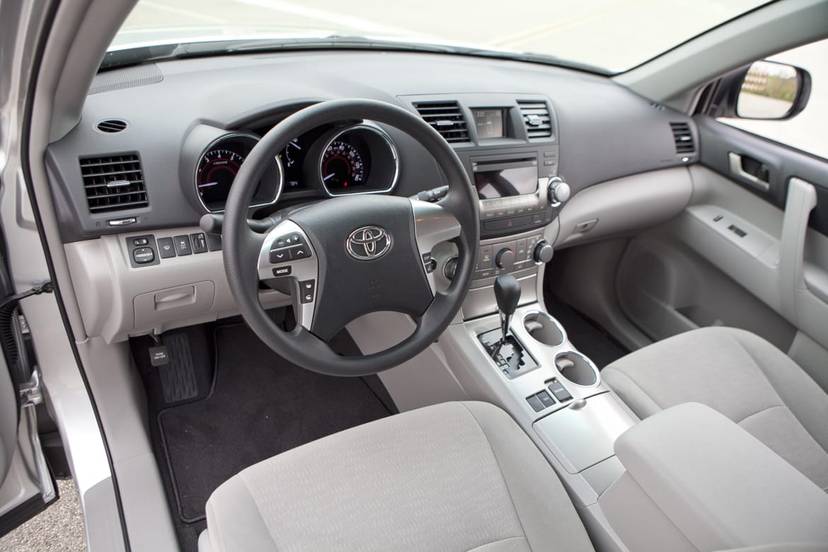
When the redesigned Highlander debuted for the 2008 model year, Toyota didn’t carry over the four-cylinder engine that existed in the previous generation; only a V-6 was available. For 2009, a four-cylinder engine was added, with benefits like a lower entry-level price and improved gas mileage over the V-6 engine. There is a separate review for the 2010 Hybrid option.
It sounds like a good formula, but I’m not completely sold. Yes, mileage is good, but it’s not outstanding, and the four-cylinder’s pricing advantage includes just minimal standard equipment. Even so, the four-cylinder Highlander is extremely easy to drive for its size, and it has competitive interior room for its entry-level price.
2010 Toyota Highlanders manufactured early in the model year are included in Toyota’s sticky accelerator pedal and floormat recalls, so be sure any necessary recall work has been done before buying one.
Four-Cylinder Power
You won’t find four-cylinder engines in five-seat competitors like the Ford Edge or Nissan Murano, or in competitors like the Honda Pilot or Chevrolet Traverse, which carry up to eight in three rows of seats. The Highlander comes standard with five seats and a second row, but two more seats can be added with an optional third row.
Gas mileage ratings of 20/27 mpg city/highway are an improvement over the V6 Toyota Highlander’s 18/24 mpg rating with front-wheel drive.
I stretched 290 miles out of the Toyota Highlander’s gas tank, returning an average of 25.8 mpg in consistent 40-50 mph trips.
In the grand scheme of things, those numbers aren’t very impressive. It’s a marginal improvement over the Highlander’s V6, plus a Ford Edge with a six-cylinder engine and front-wheel drive rates 18/25 mpg. Impressive would be a crossover this size that topped 30 mpg. That shouldn’t be too difficult to accomplish, either, as we’ve seen automakers squeeze a few extra miles per gallon out of existing vehicles with simple enhancements in aerodynamics and five-speed drivetrain gearing.
The four-cylinder did, however, provide a solid driving experience and never felt underpowered when driving through stoplight-happy suburbia. That’s impressive, considering just 187 horsepower and 186 pounds-feet of torque are lugging around a 4,000-pound SUV. Passing on the highway above 50 mph did feel sluggish, so the V6 option could prove a better alternative for those who spend a lot of time on the highway, or who frequently carry full loads or drive on hilly terrain.
Front-Wheel Drive Only
A brief encounter with foul weather in the Chicago area has me second-guessing the four-cylinder model in this region. Four-cylinder Highlanders are only available with front-wheel drive, and the tires spun easily on cold, damp roads during moderate acceleration. Traction control kicks in and stops the wheelspin, but it also halts forward momentum, which is frustrating. To get all-wheel drive, you have to get the six-cylinder engine.
Pricing & Features
With a base price of $25,855, the four-cylinder Toyota Highlander base comes with room for five occupants. That’s $1,895 less expensive than the V-6, though those Highlanders come standard with a third row.
In four-cylinder Highlanders, a third row costs $740, but it’s not well-suited for adults. I’m 6 feet tall, and I wouldn’t want to sit back there for too long. There’s also minimal cargo room behind the third row. If you’ll need to use more than five seats frequently, you may want to look at crossovers like the Pilot or Traverse, which offer more cargo space behind the third row.
The base model doesn’t offer much in the way of optional equipment. Standard features include power windows and locks, remote keyless entry, air conditioning, cruise control, an MP3 jack and a tilt/telescoping steering wheel — all common in this segment.
Other than the third row, a towing package is also available, as is rear climate control, a sunroof (new for 2010) and a six-CD changer. If you want a navigation system, leather or USB integration for an MP3 player, you’ll have to step up to a V-6 model.
This segment doesn’t have many four-cylinder contenders, but if you opt for a midsize sedan — including the Toyota Camry — you can get an efficient four-cylinder in even the most opulent trim levels with lots of luxury conveniences; that’s not the case in the Toyota Highlander.
Interior & Cargo
When the Toyota Highlander was redesigned, Cars.com reviewer Kesley Mays ranked its interior quality about average in his review. It hasn’t seen significant changes for 2010, but the competition has gotten better. Similar body-type crossovers like the Murano and upcoming 2011 Edge have a premium feel that’s almost luxurious. That’s not a feeling the Highlander’s interior gives.
It may not be the flashiest crossover, but it’s hard to beat the Highlander’s interior space and cargo room for its starting price, unless you want to consider a minivan. Maximum cargo space is 95.4 cubic feet with the seats folded, while the Edge ($27,420) has just 69 cubic feet and the Murano ($28,050) only manages 64 cubic feet.
With just 10.3 cubic feet of cargo room behind the third row, there’s hardly enough space to fit a large piece of luggage back there, and it’s only wide enough for one golf bag. The Pilot has 18 cubic feet and the Traverse has 24.4 cubic feet behind their third rows.
Ride & Handling
The general idea behind crossover SUVs is that they’re supposed to have the looks of an SUV and the ride quality of a vehicle. One of the Highlander’s strongest attributes is its easy-to-drive character; it requires little effort to steer and maneuver. It handles similar to the Toyota Camry, primarily because the Highlander is based on the Camry’s chassis.
I didn’t find a hint of sportiness in the Highlander, but that’s not a bad thing if you’re looking for a comfortable, cushy ride. I especially appreciated the sofa like front seats and its comfy ride on long-distance highway trips.
Safety
The Toyota Highlander scored the Insurance Institute for Highway Safety’s best rating, Good, in front, side and rear crash tests. It’s not yet eligible to be named an IIHS Top Safety Pick, though, because it hasn’t been tested for roof strength. Scoring Good in all four tests is a requirement for the designation. For a complete list of the Highlander’s standard safety features, see here.
Highlander in the Market
The Toyota Highlander I tested stickered near $28,000 with an optional third row, climate control for rear passengers, a roof rack and the towing package. Overall, the four-cylinder performed well, but its slight gas mileage increase isn’t a compelling argument to choose it over the V6. Though not a hybrid, the four-cylinder is a better pick if you want to save some coin on the sticker price and don’t need a third row or all-wheel drive.



















































.png)



